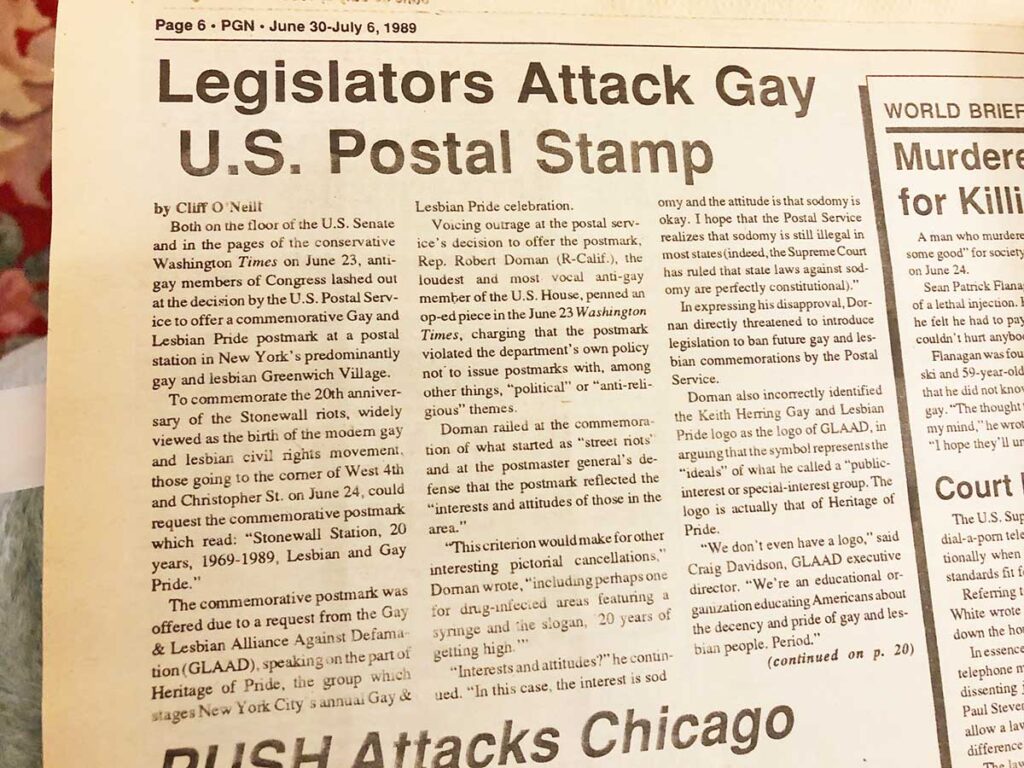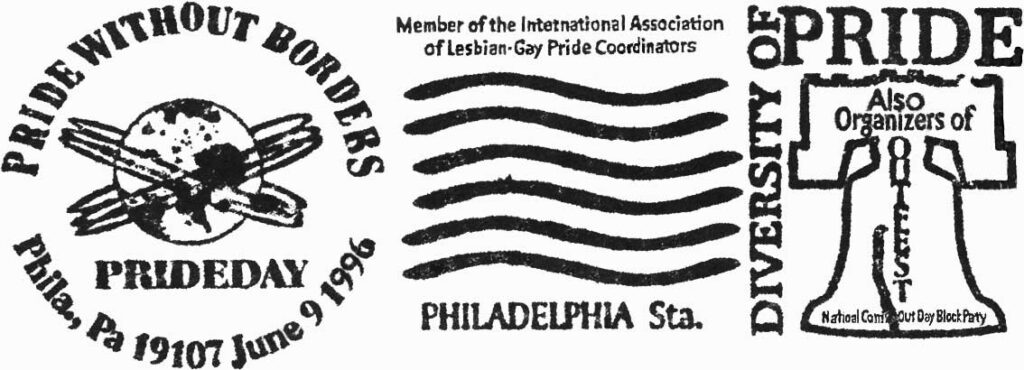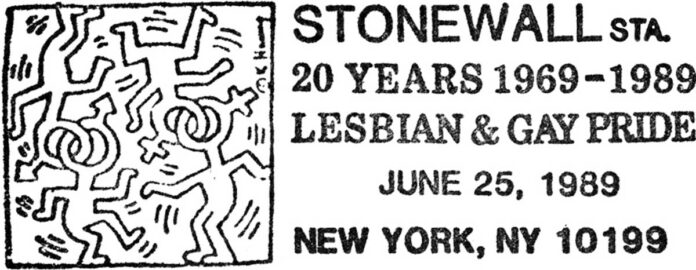Public outrage over LGBTQ rights is nothing new. On every level of government, issues including marriage equality, the removal of sodomy laws, and fair public accomodations — all touchstones in the movement for equality — have been fought against by conservatives. Most recently, members of the homophobic right have voiced grievances over the recent Supreme Court decision granting employment nondiscrimination protections to LGBTQ people.
But it’s not just the big-ticket, national news items that conservatives rally against. In the June 30, 1989 issue of PGN, Cliff O’Neill reported a lesser known gay milestone that enraged the right-wing: a Gay and Lesbian postmark available at a single post office in New York City. Postmarks are applied to stamps by the U.S. Postal Service to prevent them from being re-used.
That year on Pride Day, in commemoration of the 20th anniversary of the Stonewall Riots, the Greenwich Village post office allowed patrons to get letters and postcards stamped with a postmark that read: “Stonewall Station, 20 years, 1969-1989, Lesbian and Gay Pride.”
The postmark was requested by GLAAD after staff members read a 1988 article in The Advocate about the Gay and Lesbian History on Stamps Club, which brings together both LGBTQ stamp collectors and memorabilia. GLAAD requested the postmark on behalf of Heritage of Pride, the group that stages the New York City pride parade. It was the first LGBTQ postmark in the U.S, and it featured the Heritage of Pride logo drawn by Keith Haring alongside the Stonewall text.
According to a report from GLHSC’s 1989 summer journal, the postmark was applied between 15,000 and 25,000 times on Pride Day. USPS said that similar postmarks for NYC street fair events usually got 3,000 to 4,000 applications.

Conservatives in Congress were not pleased. Congressman Robert Doman, a Republican from California, wrote an op-ed for the Washington Times slamming the Postal Service. “I hope that the Postal Service realizes that sodomy is still illegal in most states,” Doman wrote. He continued, stating “This criterion would make for other interesting pictorial [postmarks], including perhaps one for drug-infected areas featuring a syringe and the slogan, ‘20 years of getting high.’”
Joining Doman in his disgust was Senator Jesse Helms, who spoke on the floor of the Senate and, during the height of the AIDS epidemic, declared “a pox on whoever in the Postal Service made this irrational decision.”
In response to Helms’ remarks, which also included vitriol over the “militant homosexual lobby,” Craig Davidson of GLAAD replied: “I think the nastiness of Helms’ response suggests — or reveals — the desperation of a man who knows that he is losing his battle to deny Americans the truth that gay people are decent, loving and proud.”
Helms’ remarks drew more national attention to the postmark than it had received before, during, and after its release. The GLHSC actually reported a boost in membership after his tirade made the media rounds.

Commemorative postmarks for LGBTQ pride have existed since 1983, when Stockholm, Sweden commemorated pride week there. Many post offices across the U.S. and the world have done them since the mid ‘80s, including in Philadelphia. Most recently, Wilton Manors, Florida celebrated last year’s Stonewall 50th anniversary with a commemorative, one-day-only postmark.
While stamps might be an item that most people take for granted, they have great cultural significance, including to the LGBTQ community. Stamps have been used to raise awareness for causes including HIV/AIDS and LGBTQ equality, and they have honored numerous LGBTQ people including James Baldwin, Edna St. Vincent Millay, Tennessee Williams, Harvey Milk, and Isadora Duncan, who all got their own stamp in 2017. The GLHSC journal details LGBTQ people and topics featured on stamps around the world.
The Gay and Lesbian History on Stamps Club began in 1982 and continues to this day under President Lisa Foster. Like many LGBTQ organizations in various fields, including this very newspaper, they struggled early on to be taken seriously by their mainstream counterparts. The world of stamp collecting is not immune to issues like homophobia, racism, and misogyny. In the early ‘80s the club applied to the American Topical Association, which is composed of those specializing in thematic stamp collecting (also known as philately). But the ATA rejected the group’s application without giving a reason. It took two years and assistance from the Lambda Legal Defense and Education Fund for the club to be granted membership. Now the club is a member of the ATA as well as the American Philatelic Society.
“We’ve made a lot of progress since [Jesse Helms] was around,” said Phil Stager, a member of GLHSC for 25 years. “Postmarks and stamps commemorating gay people, events, celebrations, etc. are not that unusual anymore. They are a reflection of our struggles, victories, and history.”
To learn more about GLHSC and to view images of LGBTQ postmarks, including the Stonewall 20th and Philadelphia’s gay pride postmarks, visit http://glhsonline.org/.
